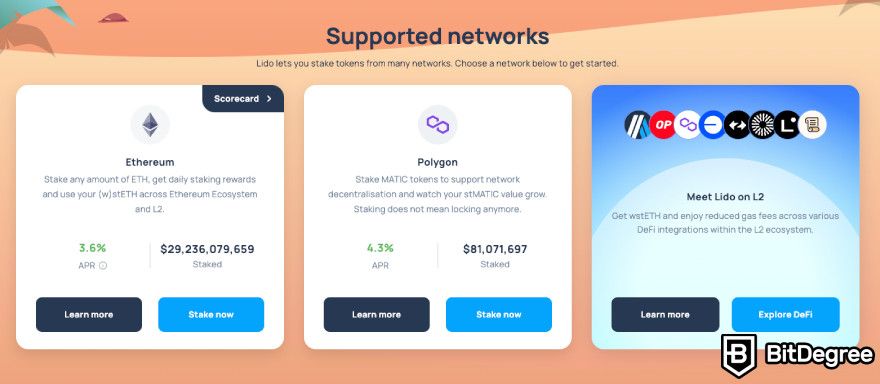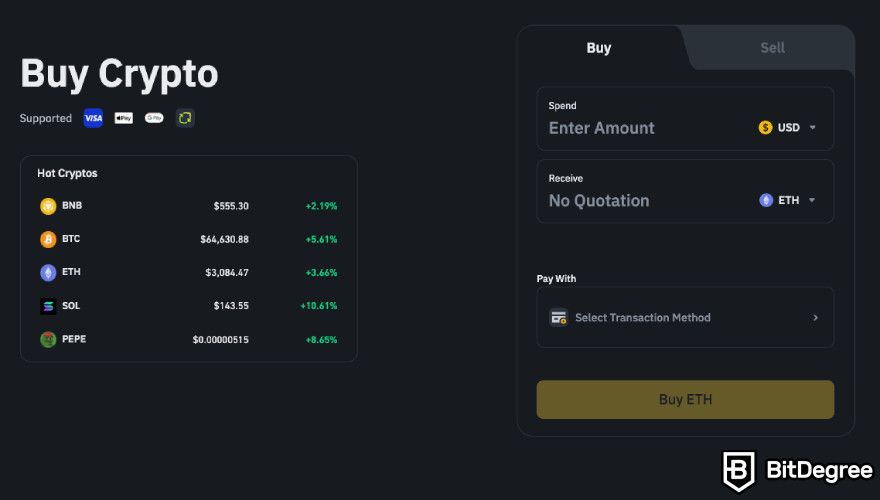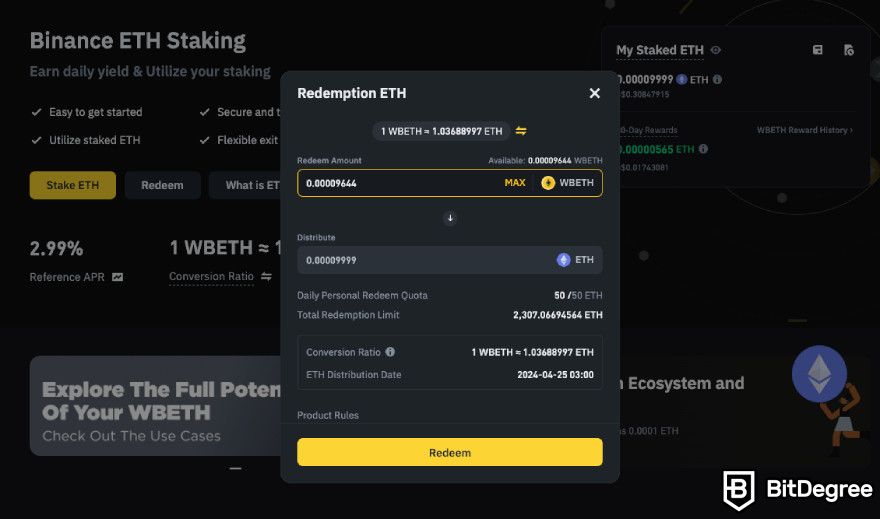Key Takeaways
- Unlike traditional staking, which often involves locking up assets for a set period, liquid staking offers flexibility, providing stakers with liquid assets in return for their staked assets;
- Liquid assets can be traded on crypto exchanges, as well as used in various DeFi protocols for additional earning possibilities;
- Liquid assets usually provide more rewards than a staker would get via traditional staking;
- When converting liquid assets back to staked assets, holders usually receive their initial stake plus the staking rewards.
Free Airdrop Season 7 is LIVE! Answer fun questions or do simple tasks to earn rewards from the $30K BitDegree prize pool. Participate Now ! 🔥
What is liquid staking in crypto? Put shortly, it's a groundbreaking concept that brings liquidity and flexibility to traditional staking. After locking up their assets, individuals receive tradable tokens (liquid assets), which represent their stake.
This flexibility enables stakers to respond to market opportunities, manage risk, and adapt to changing investment priorities promptly. You can participate in crypto liquid staking on decentralized liquid staking protocols or on some crypto exchanges, such as Binance or Crypto.com. Keeping that in mind, let’s take a closer look at what is liquid staking.

Did you know?
Subscribe - We publish new crypto explainer videos every week!
What is Shiba Inu Coin? (Explained with Animations)


Table of Contents
What is Liquid Staking?
The question of what is liquid staking in crypto has become one of the most frequently asked ones because traditional staking models have inherent limitations, particularly in terms of liquidity and flexibility.
Latest Deal Active Right Now:Head to BitDegree Missions, gather as many Bits as possible & claim your stake of the $30,000 Prize Pool! Don't waste your time & start collecting Bits by completing Missions and referring friends.
But let's start with the basics – crypto staking is the process of actively participating in transaction validation on a Proof-of-Stake (PoS) blockchain network.
Unlike Proof-of-Work (PoW) systems, where miners validate transactions based on computational power, PoS relies on validators who "stake" their crypto holdings as collateral to validate transactions and create new blocks. For doing that, they receive staking rewards, hence generating passive income[1].
However, traditional staking methods require locking up your tokens, limiting their liquidity and usability.
Crypto liquid staking addresses this issue by providing stakers with liquid assets in return for their staked ones. These liquid assets, also known as liquid staking derivatives, represent the value of the tokens one stakes and can be freely traded, used as collateral, or employed in various other financial activities within the crypto ecosystem.
This flexibility empowers users to respond to market conditions, capitalize on investment opportunities, or adjust their strategies as needed.
Now that you briefly know what is liquid staking, let’s examine its differences from traditional staking in more detail.
Liquid Staking VS Traditional Staking
I've kind of just given you a "liquid staking explained shortly" version. Now, let me expand on that. I'll start with a general overview of how traditional staking works:
Token Ownership
To participate in staking, users need to acquire and hold a certain amount of specific cryptocurrencies that belong to a Proof-of-Stake blockchain network. This means that individuals must ensure a consistent and steady accumulation of tokens to maintain their position as active participants in the staking process.
Validator Selection
Every PoS system has validators, who are chosen based on their stake or the vast number of tokens they hold. In most PoS systems, the higher the stake, the greater the probability of being selected as a validator.
Validators take turns proposing and promptly validating new blocks on the blockchain. This design is meant to encourage active participation and discourage malicious activities.
Consensus and Rewards
Validators relentlessly work together to achieve a unanimous agreement on the state of the blockchain and to ensure all transactions are valid and accurate.

As a substantial reward for their continuous dedication and participation, validators receive additional tokens, usually in proportion to their stake. These rewards serve as an effective incentive for securing the network.
Staking and Unstaking
Participants can stake their tokens by "locking" them securely in a designated wallet or smart contract intricately associated with the blockchain network. This type of staking typically involves a significant time commitment, in which tokens are securely held for a predetermined duration to adequately support the network's stability and security.
Slashing
Validators may face harsh penalties, often referred to as slashing, if they behave maliciously or egregiously fail to follow the network's stringent consensus rules. Slashing can result in the merciless loss of a substantial portion or, in severe cases, the entirety of the staked tokens.
These penalties are diligently enforced as a deterrent against any dishonest and harmful behavior, effectively safeguarding the network's integrity and fostering a sense of trust among participants. It is paramount to ensure that the staking ecosystem remains robust, secure, and resilient against potential threats.
So, to sum up, with traditional staking, users lock up their crypto assets for a predetermined period, thus contributing to the network's security. During the lock-up period, stakers are unable to access or trade their assets, as they are committed to supporting the network's operations.

The duration of the lock-up period varies depending on the specific blockchain protocol, ranging from a few days to months or even years.
Now, liquid staking works more or less the same, except for the fact that once stakers lock up their assets, they receive liquid tokens.
These tokens represent not only the intrinsic value of the staked assets but also the substantial rewards and bountiful benefits associated with them, enabling users to trade, transfer, or utilize them within the ever-growing Web3 ecosystem. Therefore, liquid staking of crypto introduces the concept of liquid staking derivatives, which can be utilized in various decentralized finance protocols, lending platforms, or yield farming protocols.
This added utility expands the earning potential of staked assets, enabling users to generate additional income and maximize their financial gains, while also actively engaging with the broader cryptocurrency ecosystem.
All in all, the essence of what is liquid staking represents a significant advancement in traditional staking. Firstly, through offering enhanced liquidity and flexibility, and then through accessibility compared to the traditional staking model.
What is Liquid Restaking?
While searching for an answer to a question "What is liquid staking?", you might also come across a process called liquid restaking.
Liquid restaking is built upon liquid staking, but it comes with a twist. It brings the opportunity of earning even more by depositing your liquid staking crypto tokens into a restaking protocol, which yields liquid restaking rewards. So, liquid restaking tokens represent the initial stake, liquid staking rewards, and liquid restaking rewards.
This approach offers users an extra layer of profit potential. However, compared to traditional staking and liquid staking, liquid restaking has the highest risk profile and poses more complex risks as you will be involved with several DeFi protocols at once.
That said, with a clear understanding of the differences between what is liquid staking, traditional staking, and liquid restaking, let's explore liquid staking crypto tokens in more detail, discussing their functionality, benefits, and the opportunities they bring to the staking ecosystem.
Liquid Staking Tokens
In the context of what is liquid staking, the introduction of crypto liquid staking tokens is exactly what revolutionized the staking landscape.
Simply put, liquid staking tokens are digital tokens that represent staked assets[2]. They are created through a process called tokenization, where the underlying crypto assets are "wrapped" or tokenized to enable their use in DeFi applications while still earning staking rewards.

The most popular crypto asset that supports liquid staking is Ethereum. Besides that, though, there are several other cryptocurrencies that support it, including Polygon, Cardano, Avalanche, and Cosmos. However, most well-known crypto liquid staking platforms and protocols usually only allow you to stake ETH.
That said, let's look over the key characteristics and aspects of liquid staking tokens:
Ownership Representation
Liquid staking tokens serve sort of like blockchain-based IOUs, attesting to the holder's ownership of the staked assets. Holders can present these tokens as proof of ownership of the staked assets and any rewards earned from participating in the network.
Liquidity Provision
Liquid staking tokens provide liquidity to staked assets, allowing holders to trade them on cryptocurrency exchanges. This liquidity enables holders to respond to market conditions and investment opportunities without waiting for the staking period to expire.
Collateralization
Since crypto liquid staking tokens are pegged to the staked assets, they hold value and are considered valid collateral. Holders can use them to acquire loans, borrow other assets, or participate in yield farming strategies on DeFi platforms.

Besides, liquid staking tokens usually have a higher value than the tokens they are pegged to because they represent the staked asset plus staking rewards.
Cross-Chain Compatibility
Some liquid staking tokens, such as Lido's stETH, are cross-chain, meaning they can be used on multiple blockchain platforms. This cross-chain compatibility expands the utility and use cases of liquid staking tokens, allowing holders to leverage different platforms for their staked assets.
Liquid staking tokens offer several benefits to cryptocurrency holders, including increased liquidity, flexibility, and opportunities for earning additional rewards. At this point, I've already talked about these things quite a lot.
However, they also come with risks. For one, liquid staking tokens rely on smart contracts to facilitate tokenization and other functionalities within the DeFi ecosystem. Smart contracts are susceptible to vulnerabilities, bugs, or exploits that could lead to financial losses or token theft.
Also, cross-chain functionality introduces additional complexities associated with smart contract interoperability and security. Holders of liquid staking tokens should be aware of these risks and exercise caution when interacting with DeFi protocols.
Despite these risks, though, liquid staking tokens play a crucial role in enhancing the utility of staked assets and driving innovation within the DeFi ecosystem.
Benefits and Drawbacks of Liquid Staking
In order to truly understand what is liquid staking in crypto, it's necessary to explore both its benefits and drawbacks (I've already talked about some of these points, so it will also be a refresher for your newly-acquired knowledge):
Benefits
Liquidity. One of the primary advantages of liquid staking crypto is that it provides liquidity to users who have locked their tokens for staking (it's literally in the name). By converting staked assets into liquid tokens, users can freely trade on crypto exchanges.
Flexibility. Liquid staking offers users the flexibility to manage their staked assets more effectively. It eliminates the need to choose between staking and liquidity since users can have both simultaneously.
They can choose to partially or fully liquidate their staked assets whenever they need funds, while still maintaining their staking position. This flexibility can be particularly useful in volatile markets or when users require immediate access to their capital.
Capital Efficiency. Liquid staking crypto enables users to maximize their capital efficiency by earning staking rewards while actively participating in other investment strategies.
These strategies mostly include borrowing or providing liquidity in decentralized finance protocols. Additionally, this liquidity allows users to access their capital and potentially earn additional returns by participating in other investment opportunities.
Drawbacks
Slashing. In crypto liquid staking, there is still the potential risk of slashing (just like in traditional staking). Slashing occurs when a validator behaves maliciously or negligently, leading to a penalty in the form of a reduction in staked assets.
When assets are liquidated and actively used for other purposes, users may have reduced oversight and control over their staking position, increasing the likelihood of unintentional actions that could result in slashing penalties. Users must be vigilant and choose reliable validators to minimize this risk.
Third-Party Risks. Liquid staking often involves relying on third-party platforms to facilitate the conversion of staked assets into liquid tokens. This introduces counterparty risk, as users need to trust the security, integrity, and reliability of these service providers.
If the third-party platform is compromised or experiences technical issues, users may face potential losses or difficulties in accessing their assets.
Volatility. Liquid staking of crypto exposes users to the inherent volatility of the cryptocurrency market. While the ability to access liquidity provides flexibility, it also means users are subject to more market fluctuations than they would be if they just kept their assets locked.
If the value of the liquid tokens decreases significantly, users may experience losses when converting their staked assets back into the desired form. Proper risk management and understanding of the market dynamics are essential to mitigate this risk.
Might Affect Governance Participation. Lastly, liquid staking might impact users' ability to actively participate in on-chain governance or voting processes. When staked assets are converted into liquid tokens, users may lose voting rights or influence over network decisions (of course, it's not the case with every network). This limitation can reduce the level of engagement and impact users' ability to shape the direction of the blockchain network.
To sum up, liquid staking offers various benefits, but it has drawbacks as well. By using this more fleshed-out concept of what is liquid staking and making informed decisions based on their specific goals, investors can reach their objectives without any preventable hurdles in the way.
How to Participate in Liquid Staking?
To deepen your understanding of what is liquid staking, it's best to get into the meat of it. So, to participate in liquid staking, you can utilize various platforms that support this functionality. I'll briefly look over a few of the most popular options before proceeding with a step-by-step guide on how to do that on Binance.
Binance
Binance is a well-known crypto exchange that offers a lot of features, one of which is ETH staking. Now, it does not refer to it as "liquid staking", but it does provide users with Wrapped Beacon ETH (WBETH) tokens that represent your staked ETH and the staking rewards you receive. You can use WBETH inside or outside Binance while still staking your ETH. So, that, by definition, is exactly what is liquid staking.

The best part is that you can start with as little as 0.0001 ETH (as opposed to 32 ETH you need for staking directly through the Ethereum network). Also, you don't need to set up or maintain nodes, because Binance does that for you.
Binance ETH staking APR is dynamic, so it changes based on Ethereum's on-chain staking rewards. As of writing, the APR is 2.99%. Just do note that Binance charges a 10% commission fee from your earned rewards.
Crypto.com
Crypto.com is another popular crypto exchange that offers liquid staking for ETH. It wraps staked ETH into Crypto.com Staked ETH (CDCETH), which holders can unwrap anytime without any conversion fees.
Holders of CDCETH can expect enhanced staking rewards, which they'll receive via an increased conversion rate of CDCETH to staked ETH.
Lido
Then, there also is Lido, a decentralized liquid staking protocol that allows users to stake ETH or MATIC and receive liquid tokens in return. It will definitely pop up when searching "What is liquid staking in crypto?".
When staking ETH on Lido, you can either receive stETH or wstETH. The latter provides you with reduced gas fees when using it across DeFi platforms within Etherum's L2 ecosystem. When it comes to MATIC, you can receive only stMATIC.

As of writing, the APR for Ethereum staking on Lido is 3.6%, while the APR for staking MATIC is 4.3%. By the way, Lido has a Rewards-Share program, which provides dedicated stakers with Lido DAO's staking rewards. To qualify for the program, participants need to show they can contribute a minimum of 2,500 ETH to Lido within a 12-24 month timeframe and be willing to promote the project.
Rocket Pool
Rocket Pool is another decentralized protocol that enables liquid staking of Ethereum. Stakers just need to deposit at least 0.1 ETH and they receive rETH in return. Rocket Pool matches liquid stakers with node operators, but doesn't charge any fees for this service.
The APR for liquid staking on Rocket Pool is also dynamic, like anywhere else. As of writing, you can get a 3.08% APR.
There is a difference between staking on centralized exchanges like Binance or Crypto.com and decentralized protocols like Lido or Rocket Pool. Centralized platforms are more convenient for newbies as they simplify the process of liquid staking, but there are risks of insolvency, mismanagement or regulatory issues.
Decentralized protocols, on the other hand, eliminate single points of failure and allow users to maintain sovereignty over their assets. However, using these protocols requires more technical expertise, and stakers might face higher gas fees, smart contract risks, and higher network congestion.

- Secure and reliable
- Accepts fiat currencies
- Lots of trading options
- Reputable exchange
- Accepts fiat currencies
- Offers various trading options

- Fiat currencies - accepted
- Simple to use
- Accepts only the most trustworthy cryptocurrencies
- A leading cryptocurrency exchange platform
- Best for beginner investors
- Accepts fiat currencies

- Fully reserved and transparent
- Multiple tradable asset classes
- Over 300 supported cryptos
- Over 300 cryptocurrencies
- Secure & transparent
- Fully reserved
How to Participate in Liquid Staking on Binance?
Okay, let's get into the details of liquid staking on Binance. Firstly, let's talk about how to start staking:
Step 1: Log in or sign up on Binance. If you're a new user, note that you'll also have to pass KYC to access ETH staking (or any other features).

Step 2: To stake ETH, you have to have ETH in your wallet. If you already own ETH and keep it somewhere else, deposit it into your Binance wallet. If not, there are various ways you can acquire it on Binance. If you're a newbie and don't have any crypto yet, the best way to do that is via the "Buy Crypto" option.

Here, you can buy ETH using fiat. Besides, there's a variety of payment methods supported, including your credit / debit card, Google / Apple Pay, and so on.
Step 3: Once you have ETH in your Binance wallet, click on the "Earn" button at the top left corner of the screen.
![What is liquid staking: the [Earn] button. What is liquid staking: the [Earn] button.](https://assets.bitdegree.org/images/what-is-liquid-staking-earn-button.jpg)
You'll be taken to the Binance Earn page. Here, hover your mouse over the "Simple Earn" button and then click on "ETH staking".
![What is liquid staking: the [ETH Staking] button. What is liquid staking: the [ETH Staking] button.](https://assets.bitdegree.org/images/what-is-liquid-staking-eth-staking-binance.jpg)
Step 4: On the Binance ETH staking page, click on the "Stake ETH" button.
![What is liquid staking: the [Stake ETH] button. What is liquid staking: the [Stake ETH] button.](https://assets.bitdegree.org/images/what-is-liquid-staking-stake-eth-button.jpg)
Step 5: An ETH staking window will pop up. Here, you just have to fill in the amount of ETH you want to stake. Remember, on Binance, you can start with as little as 0.0001 ETH.

You'll notice that the amount of WBETH you'll receive is a bit smaller than the amount of ETH you plan to put in. For example, for 0.0001 ETH I plan to stake, I'll receive 0.00009644 WBETH. But don't worry; this is only the case because WBETH has a higher value than ETH. Besides, WBETH's value will only increase over time because it represents staked ETH plus the staking rewards.
So, once you unstake, you'll get back the initial amount of ETH you've staked in addition to the staking rewards.
Step 6: The last step is clicking the "Stake" button. Once you do that, you'll receive WBETH and start your liquid staking journey.

Now, another question that might arise is how to convert your WBETH back to ETH and claim your reward. All you need to do is click a few buttons:
Step 1: On the Binance ETH staking page, click the "Redeem" button.
![What is liquid staking: the [Redeem] button. What is liquid staking: the [Redeem] button.](https://assets.bitdegree.org/images/what-is-liquid-staking-redeem-button.jpg)
Step 2: A redemption window will pop up. Pick the amount of WBETH you want to redeem and then click "Redeem".

That's it! Just note that when you submit the redemption request, you will have to wait a bit before you receive your ETH. In the meantime, WBETH will be frozen in your spot wallet and stop generating rewards.
Also, keep in mind that each platform may have its own specific requirements and instructions, so it's essential to follow their guidelines for a smooth liquid staking experience. Besides, even after having the concept of liquid staking explained, it's important to stay updated with the latest developments.
Conclusions
So, what is liquid staking? It's an alternative to traditional staking, which allows you to unleash the potential value of your staked assets while still actively engaging in the staking process. Through the conversion of staked assets into liquid tokens, you can enjoy newfound liquidity, flexibility, and capital efficiency.
After all, liquid tokens can be easily used in various DeFi protocols or traded on popular crypto exchanges, like Binance, Bybit, or Kraken. Of course, apart from the benefits, there are also a few drawbacks, including the overall crypto market volatility, as well as slashing and third-party risks.
Nonetheless, with its potential to reshape the dynamics of staking and bolster the broader adoption of blockchain technologies, liquid staking represents a significant milestone in the journey toward a more inclusive, efficient, and decentralized financial ecosystem.
The content published on this website is not aimed to give any kind of financial, investment, trading, or any other form of advice. BitDegree.org does not endorse or suggest you to buy, sell or hold any kind of cryptocurrency. Before making financial investment decisions, do consult your financial advisor.
Scientific References
1. M. Lehmann, A. Held, F. Krysa, et al.: 'Staking Your Crypto: What are the Stakes?';
2. K. Gogol, Y. Velner, B. Kraner: 'SoK: Liquid Staking Tokens (LSTs)'.













